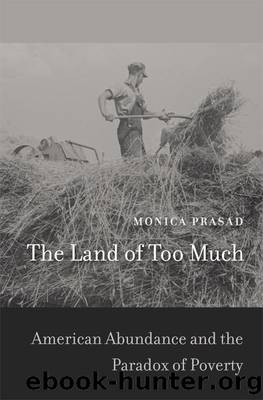The Land of Too Much by Monica Prasad

Author:Monica Prasad [Prasad, Monica]
Language: eng
Format: epub
Published: 0101-01-01T00:00:00+00:00
The Consequences of Progressivity
Despite the sparse historical record on the origins of tax preferences in the United States, we can gain some analytical perspective on them by examining why other countries did not develop a series of tax policies similar to the United States in the early twentieth century. One element that has not been emphasized in the literature on the origins of tax preferences is the very different structure of corporate taxation in the United States compared to other countries in the early twentieth century. Because of the American political focus on progressive taxation, in the early twentieth century the United States was unusual in having a separate corporate tax at all, as well as in the way that corporate tax operated. The 1913 income tax had introduced a 1% tax on corporations, raised to 12% in 1918 and 24% in 1940. In the 1930s the exclusion in the individual income tax for corporate dividends was repealed, leading to what has been called âdouble taxationâ of corporate earnings (Brownlee 2004; Bank 2010).2 No other country had this combination of progressive taxation and a fragmented democratic context early in the twentieth century. Although fully comparative data on taxes in the early twentieth century are not available, the evidence that does exist shows higher and more progressive taxes on corporations and dividends in the United States by mid-century. In 1938, one comparative study of taxation of dividends noted â[t]he most striking variance between the countries is in the very high rates imposed in this country [the United States] on those with very large incomes.⦠On the other hand rates in this country are relatively moderate in the lower and middle bracketsâ (Wall Street Journal 1940). The first year in which systematic comparisons of corporate taxation across countries become available is 1955. In this year the United States was second only to the United Kingdom in corporation tax as a percent of GDP (OECD 1981, calculated from tables 1 and 8). Ten years later, corporation tax as a percentage of GDP had plunged in the United Kingdom to one of the lowest figures among the OECD countries but remained high in the United States (OECD 2010b). This reflects both the instability and incoherence that characterizes British tax policy (Steinmo 1989), as well as American commitment to corporate taxation in this period. Corporate taxes have fallen in America since then, and risen elsewhere, so that today the United States is no longer unusually progressive in corporate taxation; however, if our aim is to understand the origins of the politics of tax preferences, the relevant comparison is corporate tax structure earlier in the twentieth century, when tax preferences arose and became politically central. (While there is a debate on who ultimately pays the corporate tax burden, the concern here is the political, not the economic, consequences of corporate taxes.)
In France, there was no separate tax on corporate income until 1948 (Delalande 2011, 382; Shoup 1955), but since 1917 there had been a tax on
Download
This site does not store any files on its server. We only index and link to content provided by other sites. Please contact the content providers to delete copyright contents if any and email us, we'll remove relevant links or contents immediately.
Harry Potter and the Goblet Of Fire by J.K. Rowling(3027)
Never by Ken Follett(2873)
Shadow of Night by Deborah Harkness(2710)
Ogilvy on Advertising by David Ogilvy(2678)
Zero to IPO: Over $1 Trillion of Actionable Advice from the World's Most Successful Entrepreneurs by Frederic Kerrest(2377)
The Man Who Died Twice by Richard Osman(2291)
Machine Learning at Scale with H2O by Gregory Keys | David Whiting(2269)
Book of Life by Deborah Harkness(2259)
How Proust Can Change Your Life by Alain De Botton(2256)
My Brilliant Friend by Elena Ferrante(2219)
0041152001443424520 .pdf by Unknown(2214)
The Tipping Point by Malcolm Gladwell(2202)
How to Pay Zero Taxes, 2018 by Jeff A. Schnepper(2095)
Will by Will Smith(2033)
Purple Hibiscus by Chimamanda Ngozi Adichie(1979)
Hooked: A Dark, Contemporary Romance (Never After Series) by Emily McIntire(1935)
Borders by unknow(1780)
Rationality by Steven Pinker(1761)
Daughter of Smoke and Bone by Laini Taylor(1739)
